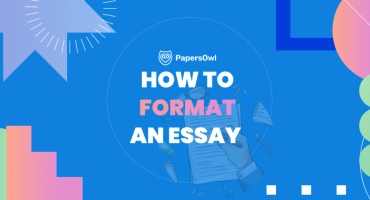Overview of MLA Research Paper Format
Table of contents
- 1 Essential MLA Style Guidelines
- 2 The First Page Structure and Format
- 3 MLA Title Page Guidelines
- 4 How to Organize Section Headings and Subheadings?
- 5 Guidelines for In-Text Citations
- 6 Recommendations for the Works Cited Page
- 7 How to Incorporate Tables and Figures?
- 8 The Importance of Proofreading and Reviewing an Academic Paper in MLA Format
- 9 MLA Handbook and Additional Resources
- 10 Summing Up
The Modern Language Association (MLA) style is widely recognized for writing and documenting research papers in the Humanities. The MLA format is particularly useful in Literature, Philosophy, and Cultural Studies. If mastering all these detailed documentation rules feels overwhelming, many students choose to pay for research paper services to ensure perfect formatting and citation.
It provides a standard approach to formatting academic papers and ensures sources are cited properly to avoid plagiarism. This standardized approach makes it easier for readers to understand the content and for writers to present their work professionally.
The MLA Handbook is the definitive guide to the MLA style. It outlines every aspect of MLA formatting, from the layout of the title page to the intricacies of parenthetical citations. Students and researchers can produce consistent, well-organized, and appropriately credited papers by adhering to these guidelines.
Essential MLA Style Guidelines
Before delving into specific formatting details, it’s important to grasp the general rules that govern MLA style. These guidelines are crucial for maintaining consistency throughout the paper.
1. Document Layout.
The MLA style requires using a standard font like Times New Roman, size 12. The entire document can’t have only one space; it should be double-spaced, including the cited list, block quotations, and works cited page. MLA recommends setting one-inch margins on all sides of the paper. The text should be aligned to the left margin, with the first line of each paragraph indented by half an inch. A page number should be included in the upper right-hand corner of each page, preceded by the author’s last name, creating the MLA header.
2. Language and Tone.
The MLA style emphasizes formal, academic language. Avoiding slang, contractions, or colloquial expressions is essential when writing a MLA paper. The paper should be written in the third person unless otherwise instructed. Capital letters are used for proper nouns and the first word of sentences. Titles within the text follow title case capitalization, with major words capitalized and minor words (like prepositions and conjunctions) in lowercase.
3. Titles and Subtitles
The paper’s title is centered on the first page without underlining, italicizing, or using quotation marks. If the paper includes subtitles, they are placed on the same line as the main title, separated by a colon, and centered. The MLA format does not require a separate title page unless specifically requested by the instructor.
The First Page Structure and Format
The first page of your MLA paper is crucial as it sets the tone for the rest of the document. The MLA heading includes your name, the instructor’s name, the course name, and the due date, aligned to the left margin and double-spaced.
After the heading on the first page, double-space and center the paper’s title. Begin the body text on the same page, with the first paragraph indented. There are no extra spaces between the title and the start of the text. The page number in the upper right-hand corner continues from this page onwards to the second page and others.
How to Structure the First Page of Your MLA Paper
|
MLA Title Page Guidelines
Unlike the ASA paper format, the MLA format does not generally require a separate title page. Still, some instructors might. If a title page is requested, center the relevant information both horizontally and vertically on the page. This includes the paper’s title, your name, the instructor’s name, the course name, and the due date. Each element is located in the next line. The title should follow title case capitalization, and there should be no extra formatting like bold, italics, or quotation marks. The title page shouldn’t have a page number unless explicitly required.
How to Organize Section Headings and Subheadings?
Section headings and subheadings are vital in structuring a paper in MLA. They help readers navigate the document by clearly indicating different sections and their content.
- Use of Headings.
Like the ASA style guide, MLA style instructions allow up to five levels of headings, each distinguished by specific formatting. For example:
| Level 1 | Centered, boldface, title case capitalization. |
| Level 2 | Flush left, boldface, title case capitalization. |
| Level 3 | Flush left, italicized, title case capitalization. |
| Level 4 | Indented, boldface, sentence case capitalization, ending with a period. |
| Level 5 | Indented, italicized, sentence case capitalization, ending with a period. |
- Consistency.
Ensure that all headings and subheadings are consistently formatted throughout the paper. This consistency aids the reader’s understanding and maintains the paper’s professional appearance.
Guidelines for In-Text Citations
In-text citations in MLA format are used to credit sources within the body of the paper. Proper citation is essential to avoid plagiarism and to give credit to original authors. Remember to check the list of things you can’t copyright before working on citations in your document.
- Basic Format
MLA parenthetical citations typically include the author’s last name and the page number from which the information was taken, with no comma.
For example: (Smith 23).
- Multiple Authors
For works by two authors, include both names connected by “and.”
Example: (Smith and Jones 45).
For three or more authors, use the first author’s last name followed by “et al.”
Example: (Smith et al. 56).
- No Author.
If a source has no author, use a shortened version of the book title or article title instead of the author’s name.
Example: (“Climate Change” 12).
- Citing Poetry and Drama.
For poetry, include the line numbers instead of page numbers.
Example: (Frost lines 14-16).
For drama, cite the act, scene, and line numbers.
Example: (Shakespeare 2.3.15-20).
Recommendations for the Works Cited Page
The works cited page is a crucial part of any MLA paper. It provides full bibliographic details of all sources cited in the paper, allowing readers to locate the original works. Make sure you understand what can be copyrighted before you complete this page.
- Page Layout
The works cited page begins on a separate page at the end of the document. The title “Works Cited” should be centered at the top of the page. It’s better to avoid the right margin. Each entry is double spaced, with a hanging indent for the second and subsequent separate lines.
- Formatting Entries
Entries are indicated in alphabetical order by the author’s last name. If there is no author, alphabetize by the title. Each entry typically includes the author’s name, the title, the publication year, and other relevant details.
Example: Smith, John. The Art of Fiction. Penguin, 2020.
- Multiple Works by the Same Author.
If you use a cited list of multiple works by the same author, indicate them alphabetically by title. Instead of repeating the author’s name, use three hyphens followed by a period.
Examples:
- Smith, John. Exploring Modern Poetry. HarperCollins, 2018.
- —.The Art of Fiction. Penguin, 2020.
- Citing Online Sources.
When citing websites, include the URL or DOI at the end of the citation. If a publication year is unavailable, include the date you accessed the material.
Example:
Johnson, Emily. “The Future of AI.” Tech Today, vol. 32, no. 4, 2023, pp. 45-58. JSTOR, www.jstor.org/stable/1234567. Accessed 15 Aug. 2024.
How to Incorporate Tables and Figures?
Tables and figures can enhance your sample MLA paper by providing visual data representations. Incorporating tables and figures into a paper in MLA requires specific formatting to ensure clarity and adherence to MLA guidelines.
- Labeling Tables and Figures
Each table and figure should be labeled with a title and number (e.g., Table 1, Figure 1) placed above the content, using capital letters for the title. The title should be concise yet descriptive enough to understand the content without further detailed information.
The data source is cited directly below the table or figure, followed by Arabic numerals, with a parenthetical citation if necessary. When referencing these elements in the text, use their corresponding Arabic numeral (e.g., “see Table 1”) to maintain clarity and coherence. It’s better to avoid using Roman numerals.
Each table and figure has a descriptive title, and this information should be placed above the table or figure.
- Placement in the Text
For a sample MLA page, tables and figures should be positioned as close as possible to their first mention in the body of the text. Ensure they don’t interrupt the text flow and are referenced within the discussion in research paper. This might mean placing them on multiple pages, ensuring they are not scattered throughout the document.
On a separate page, include a brief caption below each table or figure, which explains the content and provides the source if it is not your work. The caption should be in an easily readable font and adhere to double spacing, consistent with the rest of your MLA paper.
- Formatting Requirements
If your group project includes complex data, ensure tables and figures are formatted to be easily readable. The first line of each table and figure’s title should have a double space from the content, and the entire table or figure should be formatted with double spacing for consistency.
Additionally, include full citations for any external sources used in the Works Cited page, formatted according to MLA guidelines. Proper paper formatting of tables and figures enhances the readability and professionalism of your MLA format paper, making your research project clearer and more accessible.
The Importance of Proofreading and Reviewing an Academic Paper in MLA Format
Proofreading and reviewing your group project are essential final steps to ensure it is polished, professional, and adheres to MLA format. After finishing your paper in MLA, carefully check for grammar, punctuation, and formatting errors.
- Structure;
Review the overall structure, ensuring a clear introduction, body, and conclusion. Pay special attention to your title page (if applicable), MLA header, and MLA heading on the first page. Confirm that your paper title is centered and properly capitalized in the title case without unnecessary formatting, such as quotation marks or italics. If you include section headings in your research project, ensure they are consistently formatted according to MLA guidelines.
- In-Text Citations;
Verify that each in-text citation matches an entry in the works cited page. Ensure citations include the correct author’s last name and page number or a shortened title if no author is listed. Confirm that the works cited entries are alphabetized, properly formatted with a hanging indent, and complete with publication details.
- Formatting;
Check that your entire document has a double space without extra spaces between paragraphs and that one-inch margins are maintained on all sides. Don’t use the right margin when it is not required. The MLA recommends using a readable font like Times New Roman in size 12, so verify that this is consistent throughout your paper. Ensure your page numbers are correctly placed in the upper right-hand corner and appear on every page after the first page.
- Quotations;
Review your use of block quotations and quotation marks. Block quotations should be applied sparingly and formatted correctly, with the entire quote indented one inch from the left margin and without quotation marks. Ensure other punctuation marks are used correctly, especially with quotes, citations, and MLA formatting rules.
- Readability;
Review the document’s visual appearance, including consistent font, inch margins, clear section headings, and properly formatted tables and figures. Ensure MLA headers and page numbers are correctly placed, and the paper is easily read.
- Final Check;
Using a word processor like Microsoft Word or Google Docs can help maintain proper formatting, but it’s still vital to manually check your work to ensure compliance with MLA standards.
If you’re unsure about any aspect of your formatting or content, seeking assistance from a research paper writing service or consulting, the MLA Style Center can provide valuable guidance. You can submit a well-organized and error-free document that reflects your research and writing skills by thoroughly proofreading and reviewing your paper.
MLA Handbook and Additional Resources
Mastering the intricacies of formatting an MLA research paper requires understanding the basic guidelines and staying updated with the latest practices and interpretations of this paper format.
A wealth of additional resources and further reading are available, both online and in print, to further hone your skills and deepen your knowledge. These resources can be invaluable for students, educators, and researchers aiming to produce high-quality, well-formatted MLA papers.
One of the most authoritative sources on paper formatting is the MLA Handbook, now in its ninth edition. This comprehensive guide provides detailed instructions on everything from in-text citations to the works cited page and is an essential reference for anyone regularly working within the MLA framework. The handbook covers basic formatting rules and addresses more complex issues like citing digital sources, handling multiple authors, and structuring entries for entire edited collections. Investing time in reading what MLA recommends can significantly improve your understanding of correctly formatting and citing sources in your papers.
The MLA Style Center is an excellent starting point for those who prefer online resources. This website, maintained by the Modern Language Association itself, offers a wealth of free resources, including:
- FAQs;
- sample papers;
- instructional videos.
The MLA Style Center is particularly useful for finding up-to-date answers to specific formatting questions, such as how to cite a new type of digital media or format a group project in this writing style. Additionally, the site provides sample citations and MLA header examples, which can be immensely helpful when you’re unsure about the correct format.
Students seeking more interactive learning opportunities might consider online courses or webinars focused on MLA formatting. Many educational institutions and writing centers offer these resources, ranging from introductory courses on MLA basics to more advanced sessions that delve into the nuances of parenthetical citations and works cited entries. These courses often provide practical exercises and personalized feedback, making them a great way to reinforce your learning.
For ongoing support, consider using word processing software that offer MLA formatting templates, such as:
- Microsoft Word;
- Google Docs.
These tools can simplify setting up your MLA paper, ensuring your margins, readable font style, and page numbers adhere to the proper guidelines. However, while these templates are useful, they are not foolproof, so it’s important to cross-reference your work with the MLA Handbook or other reliable resources to catch any potential errors.
Summing Up
If you ever find yourself struggling with the complexities of MLA formatting or research writing in general, you might benefit from professional assistance. Research paper writing services can provide research paper help tailored to your needs, whether you require help with formatting, editing, or understanding what can and can’t be copyrighted. These services often employ experienced writers and editors who are well-versed in MLA style and can offer guidance on everything from the discussion section of a research paper to the proper formatting of tables and figures.
In conclusion, mastering MLA format is an ongoing process, and utilizing a variety of resources will strengthen your ability to produce a well-organized, correctly formatted MLA paper. Whether you rely on the MLA Handbook, online tutorials, or professional writing services, these resources will support your academic and professional writing endeavors.







